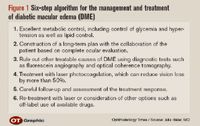Article
Algorithmic formulations may help manage DME
Chicago—Diabetic macular edema (DME), by its nature, is somewhat resistant to simple algorithmic treatment formulations because of the multifactorial nature of the decision-making process and the host of new therapies that continually become available, explained Julia Haller, MD.
Chicago-Diabetic macular edema (DME), by its nature, is somewhat resistant to simple algorithmic treatment formulations because of the multifactorial nature of the decision-making process and the host of new therapies that continually become available, explained Julia Haller, MD.
"Despite this, it still is possible to devise a relatively simple checklist to manage DME," said Dr. Haller, who is the Katharine Graham professor of ophthalmology, The Wilmer Eye Institute, Johns Hopkins University School of Medicine, Baltimore.
Dr. Haller outlined a six-step algorithm for the management and treatment of DME during retina subspecialty day at the American Academy of Ophthalmology.

The second step is construction of a long-term plan with the collaboration of the patient based on complete ocular evaluation. Whether the patient is phakic or aphakic should be determined because cataract planning may be an important consideration when DME is being treated.
The status of the optic nerve may determine whether or not steroids are prescribed. The degree of retinopathy is also important because as the severity of the nonproliferative or proliferative retinopathy increases, the treatment becomes more problematic and the visual prognosis for the DME also worsens, Dr. Haller emphasized.
Step three involves ruling out other treatable causes of DME using diagnostic tests such as fluorescein angiography and optical coherence tomography (OCT).

In this case, administration of an anti-inflammatory agent might be preferable to applying laser treatment. OCT is also showing significant epiretinal membranes and vitreomacular traction, which may require other types of interventions, Dr. Haller explained.
Vitrectomy is also a potential consideration for DME and the procedures continue to be evaluated; this includes the use of 25-gauge instrumentation and to remove epiretinal membrane complexes and the use of triamcinolone acetonide (Kenalog, Westwood Squibb).
Laser photocoagulation
Step four is the gold standard, that is, treatment with laser photocoagulation, which can reduce vision loss by more than 50%.
"The present-day laser treatment is more sophisticated than that used previously," she said.
The protocol for treatment from the Diabetic Retinopathy Clinical Research Network indicates that 50-μm burns be applied to focal microaneurysms with grid photocoagulation applied to associated areas of retinal thickening.
"We can decrease the risk of moderate visual loss in these patients by more than 50% with this type of laser treatment," Dr. Haller said.
Step five is careful follow-up and assessment of the treatment response. Despite laser treatment, some eyes have progressive visual loss; at 1 year 5%, at 2 years 7%, and at 3 years 12% of patients progress to moderate visual loss and numerous patients have persistent edema with lesser degrees of visual loss.
"These eyes may be categorized as having laser therapy failure and they tend to be problematic in other ways, in that they tend to have diffuse leakage from capillary beds," Dr. Haller said. "They can have a high prevalence of vitreoretinal interface abnormalities. In our series, 50% of patients had traction from epiretinal membranes, vitreomacular adhesions, or both."




